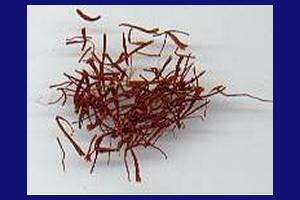| CHS021 | Saffron - Mancha Crocus sativus | ||||||||||||||||||||

|
Herbs | ||||||||||||||||||||
|
Synonyms
Alicante Saffron, Autumn Crocus, Azafran, Crocus, Gatinais Saffron, Hay Saffron Karcom, Kesa, Kesram, khesa, Safran, Safron, Spanish saffron, Stima Croci, Zaffer, Zafferano, Zafran
|
|||||||||||||||||||||

|
|
||||||||||||||||||||
|
Contraindication
Large dosages can be fatal. Saffron contains a poison that acts on the central nervous system and damages the kidneys. 10-12g can be a fatal dose in humans.
General Information
Saffron is the three stigmas of the saffron crocus. They are delicate and thread-like, each measuring 2.5 - 4 cm (1 -1.5 in). Its colour is a bright orange-red, and in high quality saffron this is uniform. Saffron bearing white streaks or light patches is inferior and when light specks appear in its powdered form it suggests adulteration.
Bouquet: Strongly perfumed, with an aroma of honey Flavour: A pungent bitter-honey tast
Traditional Use
Saffron appears in Moorish, Mediterranean and Asian cuisines. Its most common function is to colour rice yellow, as in festive Indian pilaus and risotto Milanese, where its delicate flavour make it the most famous of Italian rice dishes. It combines well with fish and seafood, infamous as a key ingredient of Spanish paella as well as bouillabaisse. In England, saffron is probably best known for its use in Cornish saffron buns where it is paired with dried fruit in a yeast cake.
Coming from the dried stigmas of the saffron crocus, it takes 75,000 blossoms or 225,000 hand-picked stigmas to make a single pound which explains why it is the world’s most expensive spice. According to Greek myth, handsome mortal Crocos fell in love with the beautiful nymph Smilax. But his favours were rebuffed by Smilax, and he was turned into a beautiful purple crocus flower. A native of the Mediterranean, saffron is now imported primarily from Spain, where Moslems had introduced it in the 8th century along with rice and sugar. Valencia coup (coupé meaning “to cut” off the yellow parts from the stigmas) saffron is generally considered the best, though Kashmir now rivals this reputation. Saffron is also cultivated in India, Turkey, China and Iran. The name is from the Arabic word zafaran which means ‘yellow’. The French culinary term safrané means ‘coloured using saffron’. Its colouring properties have been as prized as its unique flavour. In India its colour is considered the epitome of beauty and is the official colour of Buddhist robes. Saffron was used to scent t baths and public halls of Imperial Rome. Pliny wrote that saffron was the most frequently falsified commodity, which has been true throughout history. Low grade saffron has even been treated with urine to give it colour, though it has most often been falsified with dried calendula or marigold. The Romans initially brought saffron to England, though it was lost to them in the Dark Ages. It is claimed that in the 14th century a pilgrim to the Holy Land, smuggled back one crocus bulb in a hollow staff from which all English saffron supposedly descends. It is grown in great quantities in Essex, especially in a town called Saffron Essex, whose coat of arms includes three saffron crocuses. Francis Bacon wrote “it maketh the English sprightly. |
|||||||||||||||||||||
|
Related Products
| |||||||||||||||||||||
| MHS129 | Safflower petals Carthamus tinctorius | ||||||||||||||||||||

|
Dried herbs | ||||||||||||||||||||
| ABS039 | Saffron absolute Crocus sativus | ||||||||||||||||||||

|
Oil Absolute | ||||||||||||||||||||


